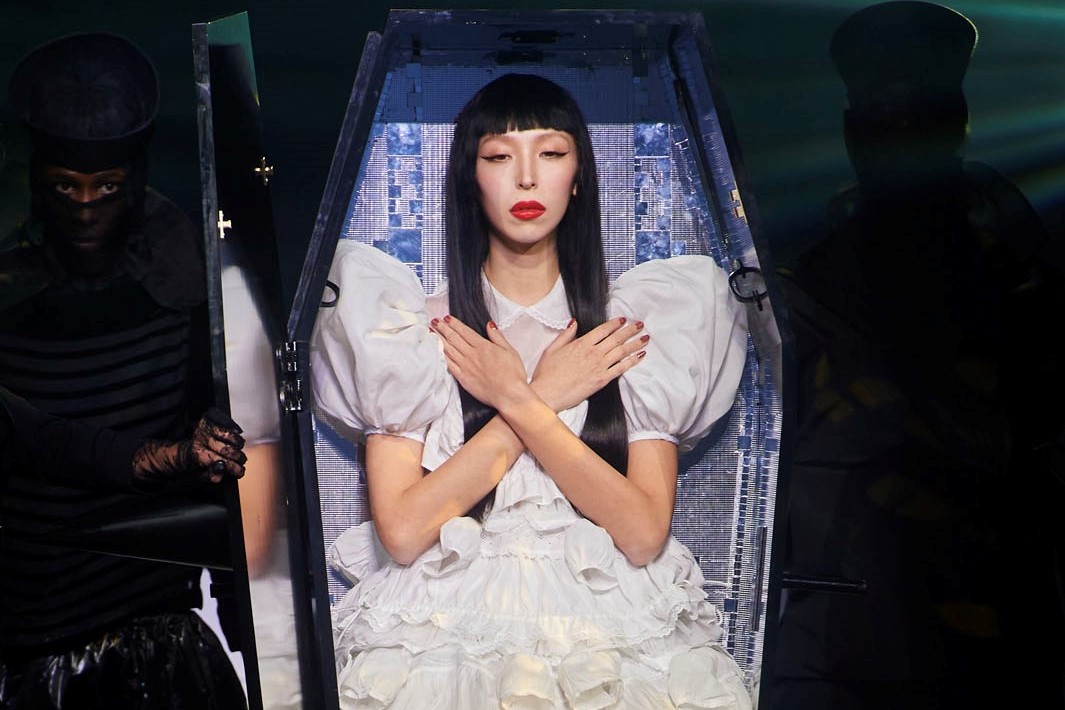
How to dress for your own death
Clothes to die for! We meet the designers and funeral directors imbuing traditional burial garb with new life
There’s a certain thrill in dressing for a special occasion, whether it’s a white wedding dress, a graduation gown, or a first-day-of-work vintage suit. Garments like these play a significant role in modern life’s most transformative experiences. But what about the garments worn after life? Funeral wear (meaning, the outfit someone wears to their own burial, cremation, or another final service) may seem like a morbid branch of occasion wear. But these garments play a key role in the grieving process and like any product of fashion, they contain layers of material and symbolic meaning.
According to funeral director Susanne Duijvestein, deceased today are dressed with comfort and individual expression in mind. “It feels natural to dress someone in their favourite clothes, like an outfit that made them feel comfortable when they were still alive.” She frequently spots deceased wearing hoodies, tracksuit pants, printed t-shirts and pieces like kimonos, which float between loungewear and ritual garments. To an objective onlooker, it might seem strange to dress the dead in something cosy. But it makes sense, counters Dr Pia Interlandi, a fashion and textiles academic and designer of funeral fashion. “We’re trying to comfort them, and we’re trying to comfort ourselves. It’s a symbolic gesture.”




Still, these comfortable t-shirts and tracksuits are still made for life, not death. Surely the two call for different dress codes? Up until recently, people wore a dedicated death outfit to their own funeral. Often taking the shape of a tunic or nightdress, these were sewn by women prior to their wedding and kept until needed. Some burial shrouds doubled as bridal nightwear or wedding dresses – like a uniform for someone’s most transformative moments. Although they are still common in an array of cultures and religions (the Islamic Kafan and Jewish Tachrichim come to mind), burial shrouds are no longer the norm in western funerals. Perhaps, like Y2K mini-bags and low-rise denim, it’s time to bring them back.
As a designer of bespoke funeral outfits, Dr Interlandi is already introducing the burial shroud into our modern time of self-expression and selfies. She reveals her inspiration came when dressing her grandfather for his funeral. “We put his shoes on and the material scientist in me, the part that understands materiality and durability, noted that these shoes were going to be around forever. But, he wasn’t going to be walking anywhere.” With sustainability becoming an increasingly pressing issue on everyone’s mind, it seems only rational to dress the dead in biodegradable outfits. After all, they have no need for rubber-soled footwear or high-durability nylon tracksuit pants.
As a sustainable practitioner, Duijvestein urges families to dress their dead in natural fabrics. After analysing countless garments she’s recovered from graves during her doctorate, Dr Interlandi crafts her biodegradable designs mostly from silk and wool. She explains that these are protein-based fibres, which is what the body is made out of as well. “Plant-based fibres, like cotton or linen, tend to go the quickest. Synthetics, including plastic buttons and most overlocking threads, will last hundreds of years.” But, as she also reflects: “Families aren’t that interested in thinking about their loved one’s body decomposing.”
The countless silk drawcords and intricate wrap-like silhouettes of her designs serve more than just an aesthetic purpose. Burial garments need to be easy to put on, either by a funeral director like Duijvestein or preferably by the families themselves. Both Dr Interlandi and Duijvestein recognise the therapeutic value in the act of dressing a deceased. Death can’t be controlled. But dressing the dead can. “So, there has to be a point of ease of dressing, it has to be physically easy because emotionally it’s already extremely heavy,” says Dr Interlandi.
To some, dressing a dead loved one, a corpse, can seem scary or even gruesome – to which Dr Interlandi shares a memory of dressing her grandfather in his shirt. “You have to weave your whole arm up the sleeve, hold their hand and pull it through. So by the time I’d pulled my grandfather’s arm out of the cuff, I was holding his hand. At that moment, I went from touching a dead body to holding my grandfather’s hand.” When it comes to burial garments, the act of dressing is perhaps more important than the piece itself.
As Dr Interlandi worked on her first commission, one by a spirited woman named Kaalii Cargill, the two were followed in an episode of ABC’s documentary series Anatomy. Then in her 60s, Cargill wasn’t dying in the acute sense but came to Dr Interlandi after losing both her parents, making her acknowledge her own mortality. This wasn’t your off-the-rack shopping experience. As they met for the first time, Cargill mused: “It’s the process of bringing it into being that’s as important to me as the garment itself.”
Together, they picked out fabrics and Cargill explained she wanted a light and unrestrictive feel. The result, a flowy silk tunic with a sunset-like gradient of burnt oranges and reds, Cargill hung in her living room like a ritualistic tapestry. She invited her family over. Reluctant at first, they discussed Cargill’s funeral with increasing intimacy, agreeing to dress her for it. “What’s kept in the pouch?” her daughter asked after a while, pointing at a golden-toned number dangling atop the tunic. “What you’d give me,” Cargill answered. Dr Interlandi was there for all of it, perhaps more of a ritual facilitator than a fashion designer. There in that living room, Cargill’s tunic was a proper conversation piece.
In the initial shock accompanied by sympathy cards and bouquets that defines early grief, it’s logical to find solace in the ritual rather than the material. “The most human thing to do is to layer symbolic meaning onto things that are out of our control,” says Dr Interlandi. After all, burial garments are meant to decay or burn alongside the deceased, making them more fleeting than the fastest of fashion. It’s their connection to life, the act of selecting them, decorating them, dressing them and reliving the memories they hold, that gives them such a permanent meaning. So, Dr Interlandi’s designs are more of a communication tool than anything else.
For the dying and their families, the Cargills included, addressing a burial outfit is a more accessible way to address death. It’s like the drawstrings on Dr Interlandi’s designs aren’t just there to connect the body to the garment, but to connect the living to death. Duijvestein, who hosts workshops on burial shroud creation, muses: “just like a funeral serves as a portrait of the deceased, a burial shroud can do so too.” She encourages her participants to use their shroud prior to death. “Let it be lived on, celebrated on, so it contains traces of life.” Fittingly, on that day in Cargill’s living room, her grandkids were armed with glitter and paint. Together, they transformed the silky white under-tunic that was part of Cargill’s death shroud, into a kaleidoscopic artwork.
When asked what they would wear to their own funeral, Duijvestein and Dr Interlandi gave surprisingly similar answers. Both mentioned a silk back-up outfit. Their respective outfits remain a work in progress. Duijvestein develops hers during her workshops, whereas Dr Interlandi has kept fabric scraps from clients’ garments to patchwork into a shroud of her own. And in that way, their respective outfits are as Duijvestein said: a portrait.



